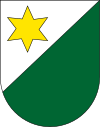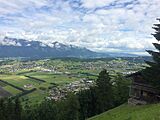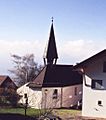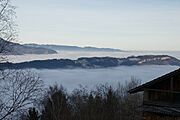Planken facts for kids
Quick facts for kids
Planken
|
|||
|---|---|---|---|
|
Municipality
|
|||
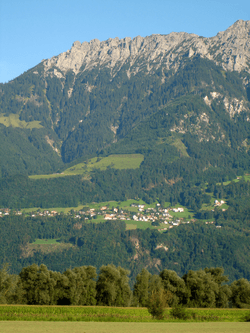
Overlooking Planken
|
|||
|
|||
|
Location of Planken
|
|||

Planken and its exclaves in Liechtenstein
|
|||
| Country | |||
| Electoral district | Oberland | ||
| Villages | none | ||
| Area | |||
| • Total | 5.34 km2 (2.06 sq mi) | ||
| Elevation | 786 m (2,579 ft) | ||
| Population
(31-12-2019)
|
|||
| • Total | 473 | ||
| • Density | 88.58/km2 (229.4/sq mi) | ||
| Time zone | UTC+1 (CET) | ||
| • Summer (DST) | CEST | ||
| Postal code |
9498
|
||
| Area code(s) | 7006 | ||
| ISO 3166 code | LI-05 | ||
| Website | www.planken.li | ||
Planken (pronounced like "plank-en") is a small town in Liechtenstein. It is part of the Oberland region. With only 473 people living there (as of 2019), it is the smallest town in Liechtenstein. Planken is known for its unique geography, which includes separate pieces of land called exclaves and enclaves.
Contents
What is Planken Like?
Planken is located on the western side of a mountain called Drei Schwestern. The main part of the village sits at 786 meters (about 2,579 feet) above sea level. Another area, the Oberplanken plateau, also belongs to the town.
Planken shares its borders with several other places. To the north, it borders parts of Gamprin, Vaduz, and Eschen. To the east, it borders the Austrian town of Frastanz. To the south and west, it borders Schaan.
Planken's Unique Geography
Planken has some interesting land features:
- Exclaves: These are parts of Planken that are separated from the main town.
- Plankner Garselli is a former mountain pasture in the Samina valley.
- Plankner Neugrütt is a forest area north of the village. It is almost completely surrounded by land belonging to Schaan.
- Wes is a small meadow and Riet-Äscher is a marsh. Both are in the Rhine Valley and are surrounded by land belonging to Schaan.
- Enclaves: These are pieces of land that belong to other towns but are completely surrounded by Planken's territory.
- Rüttistein belongs to Vaduz.
- Brunnenegg belongs to Schaan.
Mountain Pastures (Alps)
Planken has four special mountain pastures, known as "alps." These areas were traditionally used for grazing animals.
| Alp | Meaning of Name | Owner | Total Area | Pasture Area |
|---|---|---|---|---|
| Gafadura | Old Romansh for "clearing" | Municipality of Planken | 90 hectares | 24 hectares |
| Alpzinka | Means "tapering part of the alp" | |||
| Rütti | Mentioned in 1607 as "Reiti" (clearing) | 22 hectares | ||
| Plankner Garselli | Old Romansh for "small gully" (possibly) | 187 hectares | - | |
The Gafadura alp was once home to people called Walser until the 15th century. In 1579, these alps became property of the municipality. The Gafadura chalet, a mountain hut, was built in 1926 as a hunting lodge. Today, it is managed by the Liechtensteiner Alpenverein, a mountain club.
Plankner Garselli is a steep and dry alp. It was not used much for farming after the 19th century. Since 2000, it has been part of a special Natural Forest Reserve.
Planken's History
People from Schaan and Vaduz first cleared the land where Planken now stands. Later, in the 13th century, Walser people moved in and cleared the higher parts of the area. The town was first officially mentioned in a document in 1361.
Planken faced tough times in its history:
- In 1499, Swiss forces looted the village during a military campaign.
- In 1799, French soldiers looted the village during the Napoleonic Wars.
In 1868, a road was built connecting Planken to the rest of Liechtenstein. This made it easier for people and goods to travel. However, after a big fire in 1869, many people left the village. By 1901, only 56 people remained. Things got better thanks to land reforms between 1961 and 1981 and improvements to the town's buildings and services.
Interesting Places to See
The most famous building in Planken is the St. Josef Chapel. This chapel was built in the 1700s and belongs to the parish of Schaan. It is believed to have been built in 1761. A tower was added in 1861, which holds a bell from 1724. In 1929, Prince Franz I helped fund three beautiful baroque revival altars for the chapel. It was later updated in 1955.
Famous People from Planken
Planken is home to several famous alpine skiers:
- Hanni Wenzel
- Andreas Wenzel
- Petra Wenzel
- Tina Weirather
- Jessica Walter
Gallery
See also
 In Spanish: Municipio de Planken para niños
In Spanish: Municipio de Planken para niños



